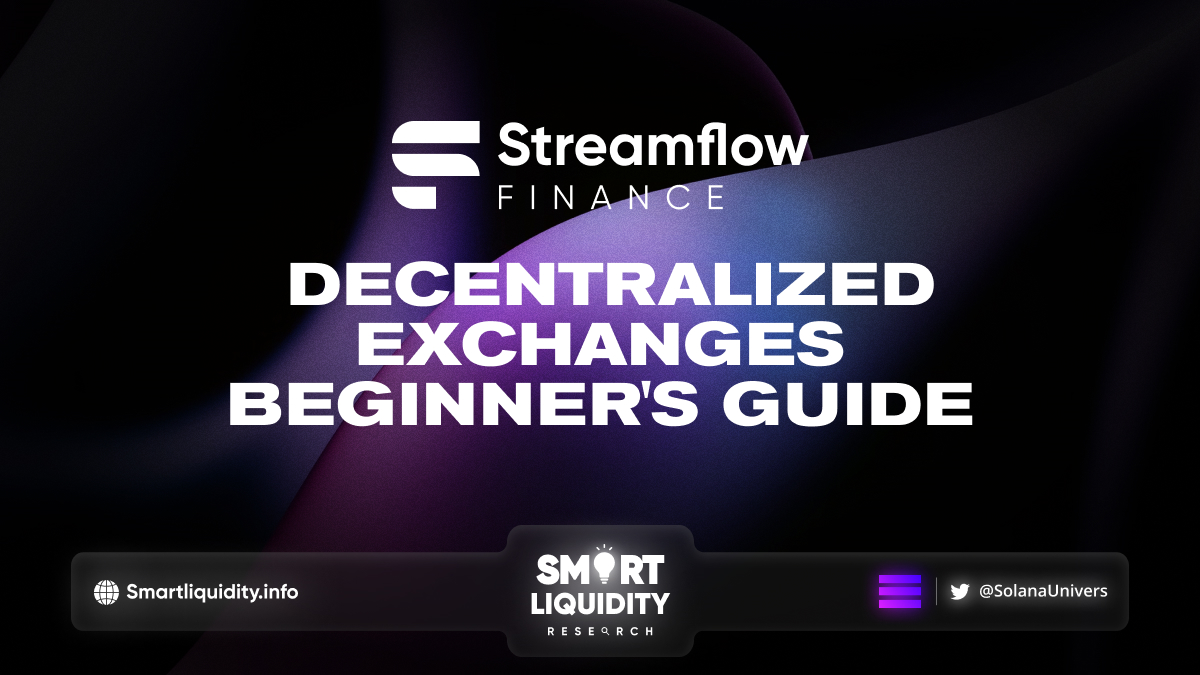Streamflow Decentralized Exchanges Beginner’s Guide


Streamflow, Solana’s leading token distribution platform, which enables organizations (and individuals) to distribute funds straightforwardly has released a beginner’s guide for decentralized exchanges.
The beginner’s guide to Streamflow decentralized exchanges discusses the benefits and challenges of utilizing DEXs, as well as their potential to alter the financial industry.
Introduction to Decentralized Exchanges
A decentralized exchange (DEX) is a cryptocurrency or digital asset exchange that works on the blockchain network. DEXs enable users to trade cryptocurrencies and other digital assets in a decentralized fashion, eliminating the need for a centralized middleman such as a conventional exchange. Users keep ownership of their private keys and assets, and transactions are recorded on the blockchain.
Individuals looking for a more safe and transparent way to exchange digital assets are increasingly turning to DEXs. DEXs use the power of blockchain technology to enable trades and allow financial transactions to be executed in a trustless and autonomous environment. Some of the most popular DEXs, such as Uniswap and Sushiswap, are based on the Ethereum blockchain and are part of the growing ecosystem of DeFi tools.
Centralized vs decentralized exchanges
Digital asset exchanges are classified into two types: centralized exchanges (CEXs) and decentralized exchanges (DEXs).
The table below compares and contrasts a CEX with a DEX:
| Feature | Centralized Exchanges | Decentralized Exchanges |
| Control | Controlled by a central authority | Decentralized; No central point of control or failure |
| Security | Vulnerable to hacking and fraud as assets are held by the exchange | Greater security, as users, retain control of their own private keys and assets |
| Privacy | Personal information and transaction details are stored on a central server | Generally provide a higher level of privacy, as protocols only interact with your wallet address |
| Censorship | Subject to censorship and government interference | Censorship-resistant, as they are not controlled by a central authority |
| Liquidity | Generally have higher trading volumes | Lower trading volumes, more limited liquidity |
| Speed | Faster transactions and order execution | Slower transaction times and more complex processes to initiate trades |
| Regulation | Generally regulated by the government | Not regulated leading to a lack of oversight |
| User experience | More user-friendly | Less user-friendly. More technical knowledge required |
How Does a Decentralized Exchange Work?
The precise implementation of a DEX determines how it operates, however most DEXs employ smart contracts to enable exchanges between users.
Here’s a quick rundown of how a DEX works:
- Users deposit their assets into a smart contract on the blockchain. This smart contract acts as an escrow for the assets and holds them until a trade execute
- Users can then place orders to buy or sell assets on the DEX. These orders are stored on the blockchain in the form of smart contracts.
- When another user places an order that matches one of the existing orders, the smart contract automatically executes the trade. The assets are transferred from the seller’s smart contract to the buyer’s smart contract, and the trade is settled on the blockchain.
- Users can then withdraw their assets from the smart contract to their wallets.
It is important to note that DEXs are developed on several blockchain platforms, therefore their functionality and user interface may differ. For trades, some employ Automated Market Maker (AMM) processes, order books, and some use liquidity pools, but the core premise of a trustless and decentralized platform remains unchanged.
Types of Decentralized Exchanges
Several types of decentralized exchanges (DEXs) have been developed with their own unique features and trade-offs.
Here are a few common types of DEXs:
- Order book-based DEXs: These DEXs use a traditional order book to connect buy and sell orders. Orders are stored on the blockchain, and when another user’s order matches one of the existing orders the trade is executed.
- Automated market maker (AMM) DEXs: These DEXs use algorithms to determine the prices of assets and match orders. Users do not need to place an order themselves. Instead, they can provide liquidity to a liquidity pool and trade directly with other users. The algorithm determines the price of all assets.
- Hybrid DEXs: These DEXs combine elements of order book-based and AMM DEXs, providing the best of both worlds. They use an order book to match large trades and an AMM to match small trades.
- Off-chain order book DEXs: These DEXs are similar to order book-based DEXs but orders are stored off-chain and only matched and settled on-chain. This method can improve performance and reduce transaction costs.
- Centralized order book DEXs: These DEXs rely on an order book for matching orders, but the order book is managed and operated by a centralized authority. These DEXs aim to provide a better user experience than off-chain order book DEXs —providing the benefits of high trading volume and low trading fees— while remaining decentralized.
Finally, the optimal DEX for each individual will be determined by the user’s personal requirements. Some DEXs prioritize security and privacy, while others prioritize speed and performance. The trade-offs may differ, and it’s critical to understand the advantages and limits of each type of DEX before deciding which one is ideal for you.
Liquidity Pools vs. Liquidity Providers
In the context of decentralized exchanges, liquidity pools and liquidity providers are both essential ideas (DEXs). A liquidity pool is a collection of assets made accessible for trade on a DEX. The pool made of assets contributed by many users in return for a portion in the pool. Other DEX users can trade the assets in the pool, and the pool’s value will change based on the demand for the assets.
Liquidity providers, on the other hand, are persons or businesses who provide assets to a liquidity pool. They do this to give liquidity to the DEX and guarantee that assets are constantly accessible for trading. Liquidity providers get a percentage of the pool proportionate to their contribution, as well as a tiny fraction of the DEX trading costs, in exchange for their commitment.
Liquidity pools and liquidity providers are critical in a decentralized exchange for providing trading pairs and ensuring that those trading pairs have adequate assets to trade. Without liquidity, traders would struggle to discover the assets they wish to purchase, sell, or trade with minimal slippage.
Dex Aggregators
A DEX aggregator is a platform that provides users with access to several decentralized exchanges (DEXs) via a single interface. A DEX aggregator’s main purpose is to make trading more user-friendly and efficient by allowing customers to compare prices and trading volumes across various DEXs and execute deals on the best available exchange. Jupiter aggregator is a popular DEX aggregator on Solana.
DEX aggregators often communicate with the many DEXs and provide the information to the user via a combination of smart contracts and off-chain infrastructure. They can link to a variety of different DEXs and combine those exchanges’ order books and liquidity pools to provide consumers with a greater selection of trading alternatives and better pricing. Some DEX Aggregators also establish liquidity pools and utilise liquidity gathered from other DEXs.
DEX aggregators are especially handy for users who wish to trade a wide range of assets since they have access to more trading pairings and liquidity than any one DEX. They are also advantageous for traders who wish to reduce slippage and obtain the best rates for their deals.
Benefits of Decentralized Exchanges
Decentralized exchanges (DEXs) have various advantages, including:
- Security
- Privacy
- Censorship resistance and no KYC
- Accessibility
- Decentralized decision-making
- Lower fees
- Community-driven
Downsides of Decentralized Exchanges
While decentralized exchanges (DEXs) provide numerous advantages, there are certain drawbacks to consider:
- Lower liquidity
- Slower transaction times
- More complex user experience
- Limited trading options
- Greater risk of smart contract vulnerabilities
- Lack of regulation
- No customer support
DEXs are a potential new form of digital asset exchange that can provide consumers with a more secure and private alternative to centralized exchanges. DEXs, like other decentralized products, have their own set of trade-offs. Before utilizing a DEX, users should weigh the benefits and drawbacks. DEXs will play an important role in the digital asset trading ecosystem as blockchain technology grows and matures. In the future, users may expect more innovation and increased functionality.
About Streamflow
Streamflow is a token distribution platform that enables organizations (and individuals) to distribute funds straightforwardly.
SOURCE
https://blog.streamflow.finance/2023/01/27/understanding-decentralized-exchanges/
REQUEST AN ARTICLE




